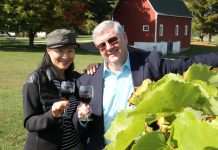
Honeybees and monarch butterflies will soon find a haven at Mari Vineyards.
The Old Mission Peninsula winery is working with the nonprofit The Bee & Butterfly Habitat Fund to create a sanctuary for insects in the vineyard.
The idea for the project grew from the grapes.
“We’re a 100% estate-grown winery, which means that all of our grapes are grown on Old Mission Peninsula,” says Bonnie Hardin, sales and marketing coordinator for Mari Vineyards. “So we never get any fruit from elsewhere, which means that the fruit we’re growing is really intrinsic to what our identity is, coming from Old Mission Peninsula and representing our wine trail and our region.”

“When you’re growing grapes,” she continues, “you really want to start with the soil, and you want to look at the whole habitat the grapes are growing within and [think] about the interconnectivity of everything.”
Over the decades, vineyards and farms on the Old Mission Peninsula have largely participated in monocropping, where a single crop is grown on the land year after year, which over time strips nutrients from the soil. Much further back in time, when glaciers shaped the area, they also depleted the soil of nutrients, Hardin says.
“Looking at all of this, we really want to start with the soil and try to get the plants in an environment that’s as healthy as possible, so we looked for a nonprofit that works in this area, and we found a group that’s called The Bee & Butterfly Habitat Fund,” she says.
Creating a Sanctuary
The Bee & Butterfly Habitat Fund was founded in 2014 with the goal of helping farmers and landowners develop habitats for honeybees and monarch butterflies in response to the continual loss of high-quality environments for those species. The nonprofit is active in several states across the country.
The organization worked with Mari Vineyards to create a customized seed program for an insectary on the winery’s property.
While The Bee & Butterfly Habitat Fund focuses specifically on supporting honeybees and monarch butterflies, Mari Vineyards was looking to bring biodiversity to its vineyards more generally to nurture a more nutrient-rich and balanced ecosystem.
“When you create something like an insectary, it helps bring a lot of those life cycles back to places where they may not have been occurring just because of that monocrop,” Hardin says.
The winery began working with the habitat fund in spring 2021 and soon began planting in its Bella Vista vineyard, which is located just off the winery’s patio. The first step was to plant sunflowers where the future insectary would be to prep the soil.

The sunflowers came up in late summer 2021. That fall, the vineyard team cleared the sunflower patch and after the first frost planted wildflowers — such as cosmos, butterfly bushes, bachelor’s buttons, and sunflowers — on the plot.
As part of the contract with The Bee & Butterfly Habitat Fund, the habitat will remain undisturbed for five years. The flowers are expected to come up next spring.
“The end goal would be to continually foster this environment,” Hardin says. “We keep it left alone for [five] years, and over the course of that time, all those wildflowers are going to populate, and we’ll slowly see that chunk of land become a little bit more of a self-sustaining environment.”
A Healthier Habitat
Mari Vineyards hopes to expand the project to its other six vineyards. The insectaries are also part of a larger move toward sustainability and eco-friendly practices. Just this spring, the winery has started working on a kitchen garden, where fruits, vegetables, herbs, and edible flowers will be grown and ultimately used in the kitchen.
“We’re basically just trying to bring the kitchen into alignment with everything else that we do, which is really focused on being estate-grown and that farm-to-table, so to speak, mentality of just really utilizing what’s local,” Hardin says.

The Mari Vineyards team has also started a “really aggressive” cover-cropping program, she says. As part of that initiative, they’ve planted vegetables such as turnips, peas, beans, and radishes between rows of vines in the vineyards. The plants help add nutrients to the soil as well as aerate it.
These projects are driven in large part by Mari Vineyards’ vineyard manager, Dave Bos, who is well known nationwide for his focus on sustainable farming.
“The overall goal is basically just to be creating a healthier habitat for our farm and for all of the different aspects of the farm,” Hardin says. “A lot of our mission at Mari is to be as sustainable, as carbon-neutral, and as green as possible. And bringing all of those missions and that ethos into every aspect of what we do is becoming increasingly important for us.”












Facebook Comments